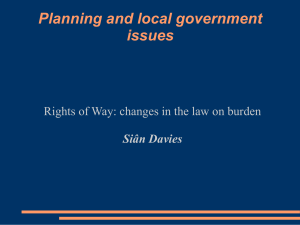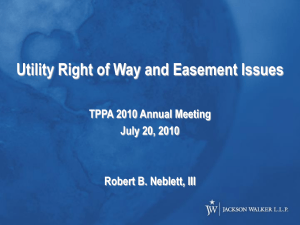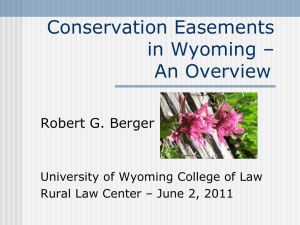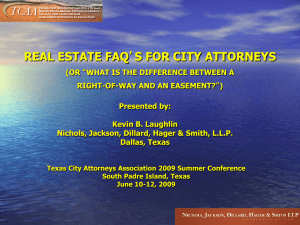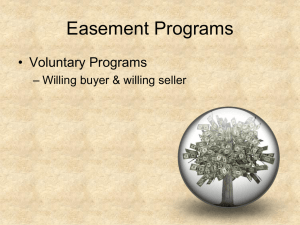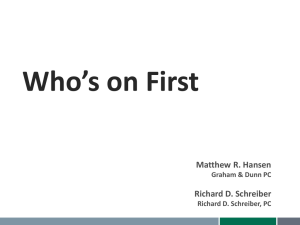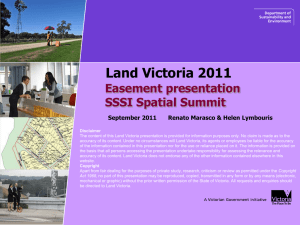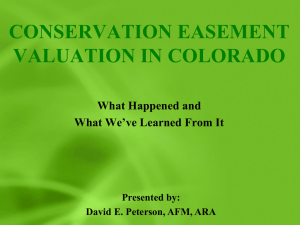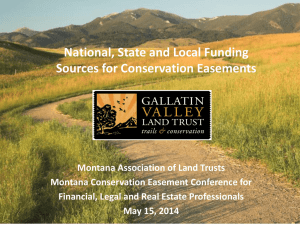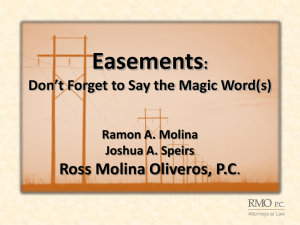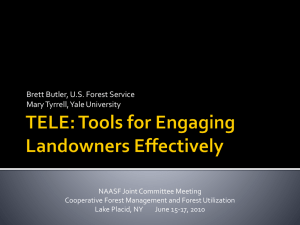Easements in oil and gas law - Welborn Sullivan Meck & Tooley
advertisement
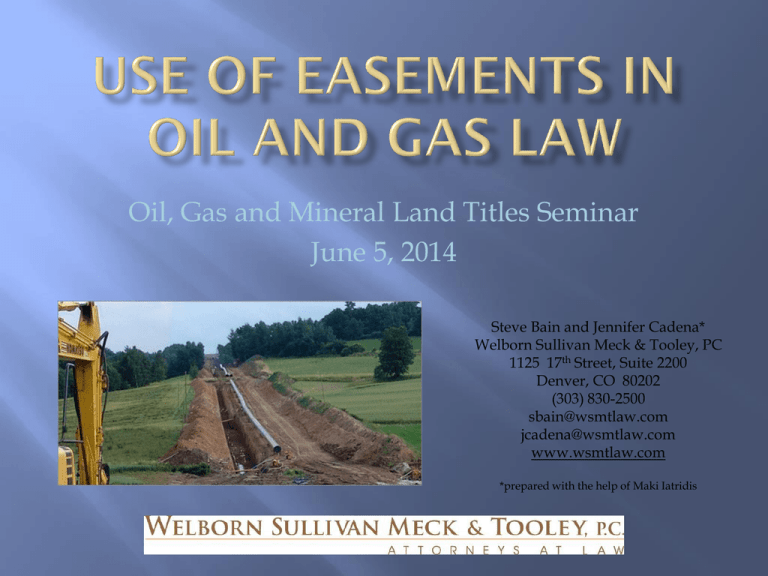
Oil, Gas and Mineral Land Titles Seminar June 5, 2014 Steve Bain and Jennifer Cadena* Welborn Sullivan Meck & Tooley, PC 1125 17th Street, Suite 2200 Denver, CO 80202 (303) 830-2500 sbain@wsmtlaw.com jcadena@wsmtlaw.com www.wsmtlaw.com *prepared with the help of Maki Iatridis EASEMENT Non-possessory interest in real property Non-possessory: Use of the land belonging to another Real Property If you have an easement, you do not own the land, but have a right to use it for a particular purpose “Typically” runs with the land 2 EASEMENT The pipeline company needs an easement from the surface owner Can be exclusive or nonexclusive Surface owner will limit ability to use surface Pipeline Specified time “One year after the pipeline is no longer used” 3 LICENSE Not an interest in real property Yearly payment Personal, non-assignable Revocable 4 5 Can a License be obtained for a pipeline? 6 Yes, but who would want to? …. Licenses are hardly ever used 7 General Examples Pipelines Drainage Utilities Roads (RS 2477) Railroads (in patent) Access to development of minerals 8 Types of Easements generally In Gross Appurtenant Purpose and intent determines If unclear, presumption is appurtenant Lewitz v. Porath Family Trust, 36 P.3d 120 at 122 (Colo. App. 2001) 9 Personal Interest No connection with the land Roads and utilities, typically 10 Runs with the land Example 1: I own Parcel A and have an easement over Parcel B You purchase Parcel A from me by deed, but it doesn’t mention an easement When you purchase Parcel A, do you also get the easement? A B 11 Runs with the land Example 2: I own Parcel B which is “burdened” by an easement You purchase Parcel B from me by deed, but it doesn’t mention an easement When you purchase Parcel B, are you “burdened” by the easement? A B 12 Creates “dominant” and “servient” estates Dominant - Who benefits from the easement? Servient – Who is serving the other? Who owns the property on which the easement is located? A B 13 Creates “dominant” and “servient” estates Dominant - Who benefits from the easement? Servient – Who is serving the other? Who owns the property on which the easement is located? A A (Dominant) B (Servient) 14 Dominant May do whatever is reasonably necessary to use easement Servient Can’t “unreasonably” interfere with easement Although servient owner retains right to use easement area, this use must be consistent with easement owner’s rights A B 15 Express Grant Reservation Implication Necessity Pre-existing Use Prescription 16 Grant/Reservation Signed by landowner bound by easement May be in a deed or separate agreement Mineral Deed example: Grantor deeds Grantee “all right, title and interest in and to all of the oil, gas and other minerals located in, on and under [Blackacre] . . . together with the right of ingress and egress at all times for the purpose of exploring, operating and developing said lands for oil, gas and other minerals and storing, processing, treating, transporting and marketing the same therefrom and to use so much of the surface of the land as is necessary or convenient for any such activities . . . .” 17 Oil and Gas Lease may contain express grant Lessor hereinafter leases to Lessee the oil and gas . . . “together with the right of ingress and egress and the right to conduct operations including, but not limited, to construct and maintain pipelines, telephone and electric lines, tanks, powers, ponds, roadways, plants, equipment, and structures thereon to produce, save and take care of said oil and gas . . . .” If not express, then implied 18 Not expressed in writing Implied by the transaction Typically, by necessity or by preexisting use 19 Necessity (common law & by statute) Common ownership No other way to access land Must be current and continuing Lack of necessity terminates claim Payment A B 20 Necessity Common ownership No other way to access land Must be current and continuing Lack of necessity terminates claim Payment A B 21 Necessity Common ownership No other way to access land Must be current and continuing Lack of necessity terminates claim Payment A B 22 Preexisting Use Level of “necessity” may be less than access to property A B 23 Unopposed Continuous trespass Statutory period of 18 years Open, notorious, visible and adverse 24 Voluntarily Agreement by parties Quitclaimed by easement owner Express terms of easement instrument Abandonment Voluntary, affirmative acts Intent to abandon 25 Trespass if easement holder exceeds “scope” of easement 26 Facts: I own Parcel A in fee I deed you Parcel A, reserving the minerals That deed does not mention an easement to access the surface of the property Do I have an easement to develop the minerals? 27 YES Similar to an easement by necessity Without this implied easement, the mineral owner will not be able to develop his/her minerals 28 Do I have an easement on the surface to access adjoining land? NO, the easement is limited to developing my minerals – unless there is an express easement allowing me to access adjoining land 29 How much surface of the land can I (or a lessee) use to develop the minerals? 30 Traditional Rule May use surface to extent reasonably necessary Allows mineral owner to use the surface without obtaining surface owner’s permission or paying surface owner for compensation Mineral owner may not destroy the surface Can include drilling/operating wells and constructing roads and pipelines 31 But, what is reasonable? 32 Modified Traditional Rule No longer merely extent reasonably necessary Focus on “accommodation” – there must be “due regard” for the surface owner and mineral owner You must attempt to “accommodate” each other The accommodation doctrine has been codified. C.R.S. § 34-60-127 An operator may still enter upon and use that amount of the surface as is “reasonably necessary.” 33 But, what is reasonable? 34 Due to the possible litigation as to what is “reasonable,” operators typically obtain surface use agreements According to C.R.S. § 34-60-127: The standard of conduct set forth in this section shall not be construed to abrogate or impair a contractual provision binding on the parties that expressly provides for the use of the surface for the conduct of oil and gas operations or that releases the operator from liability for the use of the surface. 35 36 SURFACE USE AGREEMENT shall mean any agreement in the nature of a contract or other form of document binding on the Operator, including any lease, damage agreement, waiver, local government approval or permit, or other form of agreement, which governs the operator’s activities on the surface in relation to locating a Well, MultiWell Site, Production Facility, pipeline or any other Oil and Gas Facility that supports oil and gas development located on the Surface Owner’s property. 37 Timely and hassle free access Provide tubing for corrals Cattle guards Grading and gravelling driveways Water supply wells Updating landowner’s abstract Dust suppression Repairing/upgrading fences* * James J. O’Malley & Kendor P. Jones, “Chained Gates and No Trespassing Signs: Dealing with Wary Landowners in a Brave New World,” 51 Rocky Mt. L. Inst. 7-1, 7-23 (2005). 38 Timing and coordination of drilling operations Segregation of topsoils Location of production equipment Noise control Visual aesthetics Protection of water wells Fencing and protection of livestock Safety issues Indemnification and liability issues Reseeding and reclamation * James J. O’Malley & Kendor P. Jones, “Chained Gates and No Trespassing Signs: Dealing with Wary Landowners in a Brave New World,” 51 Rocky Mt. L. Inst. 7-1, 7-24 to 7-25 (2005). 39 Seismic work Access Construction of locations for wells, tank batteries, meters and processing equipment Construction of roads, flowlines, gathering lines and power lines Compressor siting Cutting of fences and trees Workover operations* *See Christopher G. Hayes, “Surface Use Agreements,” Severed Minerals, Split Estates, Rights of Access, and Surface Use in Mineral Extraction Operations, 15-1, 15-4 (Rocky Mt. Min. L. Fdn. 2005). 40 41 COGCC Setbacks In 2013, setbacks increased from 150–350 feet to 500–1,000 feet Proposed Ballot Initiative Setbacks No. 85 – 1,500 feet and no taking No. 86 – 2,000 feet and no taking No. 87 – 1/2 mile and no taking No. 88 – 2,000 feet 42 Who leased first? How soon is each likely to be developed? Can development be staggered? Safety concerns Height concerns 43 Jennifer Cadena Steve Bain Welborn Sullivan Meck & Tooley, PC 1125 17th Street, Suite 2200 Denver, CO 80202 (303) 830-2500 sbain@wsmtlaw.com jcadena@wsmtlaw.com www.wsmtlaw.com 44
